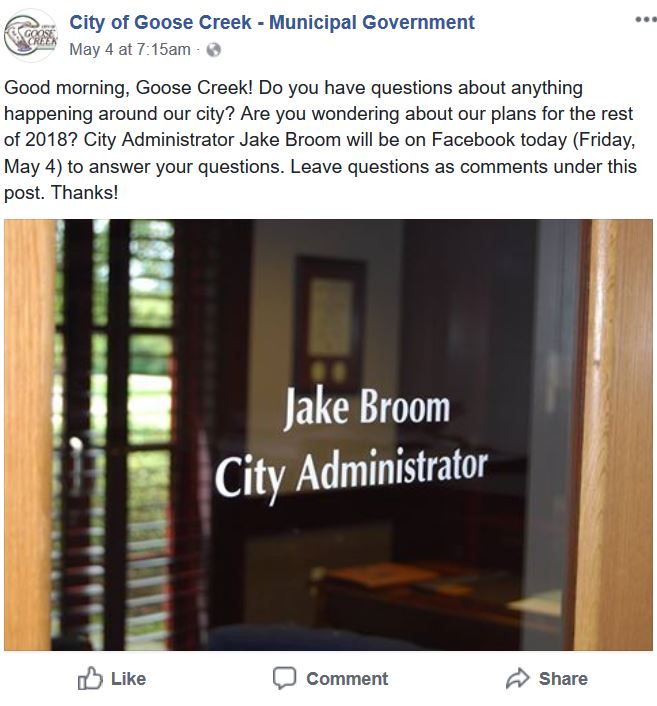When Jeff Lord looked across the room full of residents in front of him, most of them were staring down at their phones, texting during his presentation. But he didn't mind. In fact, it was just as he had hoped.
Lord, the town administrator of Moncks Corner, was using a web-based audience response system to gather instant opinions during a meeting about whether the town should start offering emergency medical services. As residents texted their answers, a bar graph on a screen at the front of the room shifted in real time to reflect their views.
"A lot technical things go into the decision of EMS, so this was a way to keep them engaged," said Lord of the Poll Everywhere program.
"A lot of questions were like, 'How long do you think it should take for an ambulance to get to you?' That led into the conversations about response times. It was kind of a way to check people's expectations to standards."
It's still true that the squeaky wheel gets the grease. But Moncks Corner and other cities have found ways to make sure that all parts of the vehicle — not just the wheels — are also heard.
"A lot of times you only get the most diehard on one side of the issue," Lord said. "When in fact, a large part of the constituency is concerned but would rather not stand up to speak."
While cellphones are handy, colored dots can work, too. In the Town of James Island, residents got to weigh on the town's Pinckney Park design and amenities as part of its "dotmocracy," a concept the town learned about from the Town of Mount Pleasant.
It worked like this: Town officials gathered residents in a room, wrote down everyone's suggestions and handed each resident some color-coded dots. The dots had points assigned to them, allowing residents to give an idea the appropriate dot to correlate to how strongly they felt about a given suggestion.
The dotmocracy event allowed residents to rank future park amenities and attributes, such as whether the park should have restrooms, alcohol allowed, a historical interpretive center, disk golf and other features.
A list of about 50 suggestions in order of dot-based rank — a special events stage, a canoe and kayak launch, and "marsh left alone" ranked the highest — is posted on the James Island website.
Most recently, James Island used the dotmocracy method to find out what residents wanted in a new town hall.
"The architects posted a great deal of inspiration images on the walls, and residents placed dots on the images that appealed to them the most," said James Island Town Administrator Ashley Kellahan.
Reaching beyond council chambers
When Jake Broom started in his position as administrator for the City of Goose Creek in 2016, he introduced himself through the city's Facebook account.

Soon afterward, "Ask the Administrator" was born, a chance for residents to get real-time answers from Broom by posting questions to the city's Facebook page and receiving responses. Residents wanted to know about the city's finances, the status of the fire department's radio system, dead tree removal, speeding concerns in a particular neighborhood and whether a dog park would be opening.
"Ask the Administrator" also helped combat rumors that spread across Facebook pages that weren't affiliated with the city. The most common rumor was that the city was picking and choosing which businesses could come into the city. Broom's "Ask the Administrator" sessions, which were then shared on the noncity pages where some rumors had flourished, helped put those rumors to rest.
"The belief existed that certain businesses are not here because we don't want them here," he said. "But that's not true. So we let them know what's going on and how we're working to recruit these businesses. … We're doing all we can to recruit the types of businesses they want to see, but that's something they're not necessarily aware of unless we tell them."
The way Broom sees it, of the tens of thousands of city residents, only 30 may show up to a City Council meeting.
"But about two or three thousand will see my Facebook posts," he said. "The reach is exponential."
'Crystalizing public opinion'
Polling the public first often leads to better decisions and also better-received decisions.
In one year — from 2016 to 2017 — the number of business license applications that poured into the Town of Bluffton increased by nearly 11 percent, from 2,809 to 3,104 applications.
Even before that, however, Bluffton officials were trying to figure out how to make the business licensing process both more user friendly and more business friendly. In April, the town hosted a public meeting to discuss various ideas. But that's not all they did.
They put a business owner survey on Facebook and the town's website, distributed a press release to local media and residents' distribution lists, and also informed the local Chambers of Commerce of the meeting and survey.
While only a handful of business owners showed up to the public meeting, representatives of a real estate agent association and the Chamber of Commerce attended and spread the information to hundreds of their members. Several ideas took shape, including special incentives for in-town businesses, discounts for startups during their first few years and changes to the license renewal date.
"When Town Council embarks on updating or streamlining an existing ordinance, such as the business license law, it is the town's duty to ask what works best with its business owners," said Debbie Szpanka, public information officer.
"Crystalizing public opinion is a part of the process."
